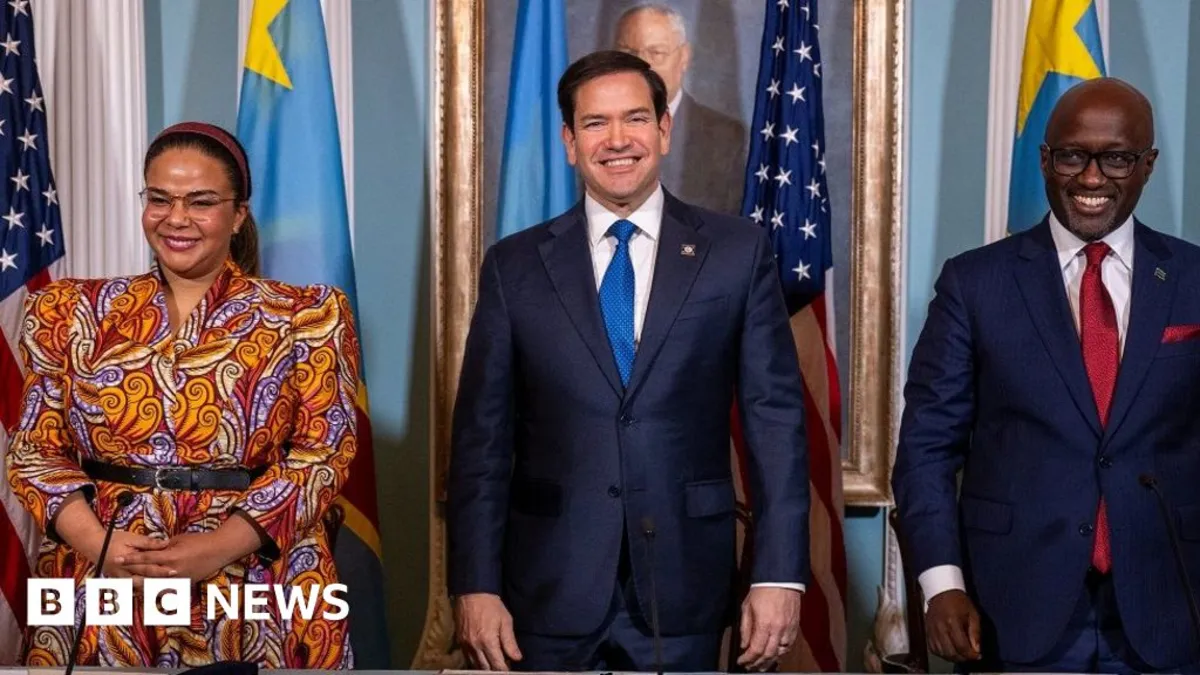
Rwanda and the Democratic Republic of Congo (DR Congo) have taken a significant step towards peace by signing a historic agreement in Washington, D.C. This peace deal aims to put an end to decades of destructive conflict between these neighboring countries and may also provide the United States with access to lucrative mineral resources in the region. The agreement mandates the disengagement, disarmament, and conditional integration of armed groups operating in eastern DR Congo, reflecting a commitment to long-term stability.
While details about the peace deal remain limited, the leaders of the US and DR Congo have heralded this agreement as a major victory. U.S. President Donald Trump emphasized the importance of this moment, stating, “Today, the violence and destruction comes to an end, and the entire region begins a new chapter of hope and opportunity.” Standing alongside Vice-President JD Vance, Secretary of State Marco Rubio, and representatives from both countries, Trump described the peace treaty as a “glorious triumph” for the involved nations.
The peace deal was formally signed by the foreign ministers of DR Congo and Rwanda at the U.S. State Department, marking a diplomatic milestone for President Félix Tshisekedi of DR Congo. His office referred to this agreement as "certainly the most important" diplomatic achievement in over 30 years. Discussions have suggested that both Tshisekedi and Rwanda's President Paul Kagame may visit Washington together in the near future, although a date has yet to be confirmed.
The ongoing conflict in DR Congo has deep roots, with tensions escalating significantly earlier this year when M23 rebels took control of vast areas in eastern DR Congo, including the regional capital of Goma, the city of Bukavu, and two critical airports. The recent surge in violence resulted in thousands of deaths and the displacement of hundreds of thousands of civilians. Following these territorial losses, the Kinshasa government sought assistance from the U.S., reportedly offering access to essential minerals in exchange for security guarantees.
Eastern DR Congo is known for its rich deposits of coltan and other resources that are crucial for global electronics industries. Despite overwhelming evidence of Rwandan support for the M23 rebels, Rwanda maintains that its military presence in DR Congo is purely defensive, aimed at countering threats from armed groups like the FDLR, which is connected to the 1994 Rwandan genocide. Conversely, Rwanda accuses the Congolese government of supporting the FDLR, a claim that DR Congo vehemently denies.
Upon the release of preliminary information about the peace agreement last week, discussions indicated provisions for the respect of territorial integrity and a prohibition on hostilities, although specifics were lacking. The deal also mentioned facilitating the return of refugees and internally displaced persons. Reports suggest that Congolese negotiators had initially pushed for the immediate withdrawal of Rwandan troops, which number around 7,000 on Congolese soil, but Rwanda opposed this demand.
Rwanda's Foreign Minister Olivier Nduhungirehe expressed frustration over leaks of the peace agreement draft, emphasizing the need for confidentiality during negotiations. The contentious issue of Rwandan troop withdrawal remains unresolved, with Nduhungirehe noting that terms like “Rwanda Defense Force,” “Rwandan troops,” or “withdrawal” do not appear in the final document. However, just hours before the signing, Tshisekedi’s office claimed that the agreement includes provisions for Rwandan troop disengagement, opting for this term over “withdrawal” for its broader implications.
Despite the signing of the peace treaty, several crucial questions linger regarding its implementation. Will the M23 rebel group withdraw from the territories they currently occupy? Does the respect for territorial integrity imply that Rwanda acknowledges its military presence in eastern DR Congo and agrees to withdraw? Furthermore, will the agreement facilitate the return of thousands of Congolese refugees from Rwanda? Will disarmament efforts lead to the M23 laying down their arms? Who will take responsibility for disarming the FDLR, especially considering past failures in this regard? Lastly, will the humanitarian access provisions allow for the reopening of rebel-held airports to facilitate aid delivery?
Prior to the signing event, Rwandan spokeswoman Yolande Makolo indicated that any decision to lift defensive measures in the border area would be contingent upon the neutralization of the FDLR. The M23 rebels, a key player in the current conflict, emerged from a previous peace deal 16 years ago that failed to ensure their demobilization. Last year, agreements were reached between Rwandan and Congolese experts under Angolan mediation regarding the withdrawal of Rwandan troops and joint operations against the FDLR; however, these agreements were not endorsed by ministers from both countries. Angola ultimately stepped down as a mediator in March, highlighting the challenges ahead.